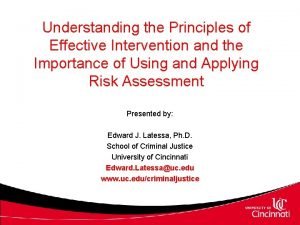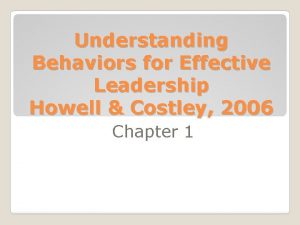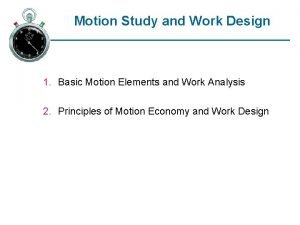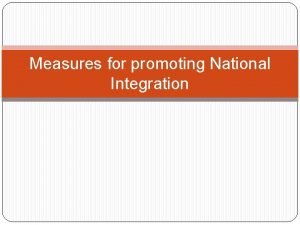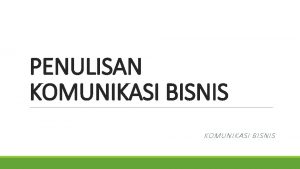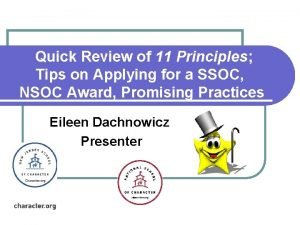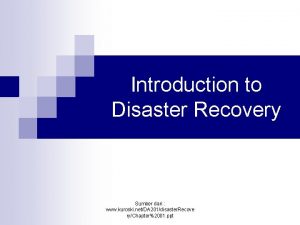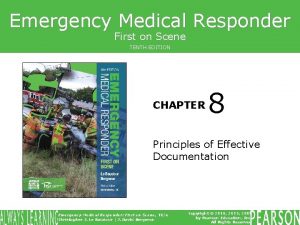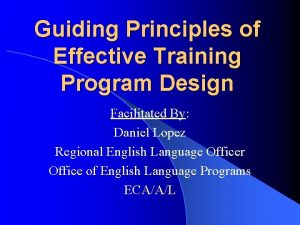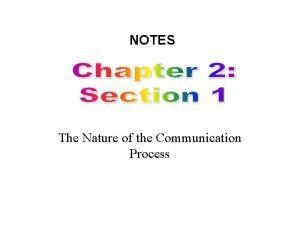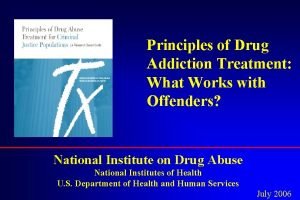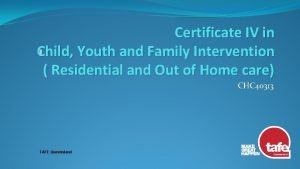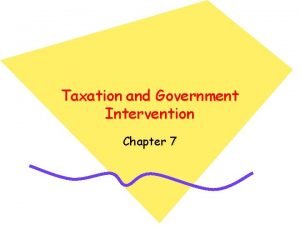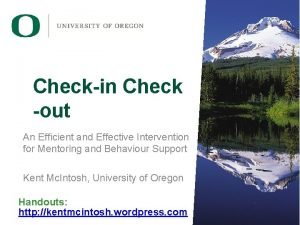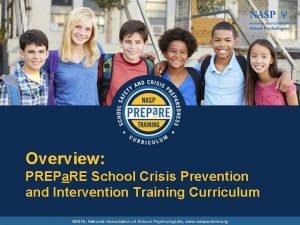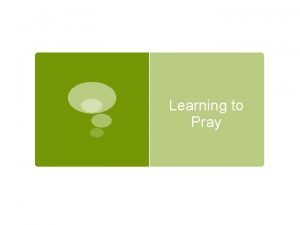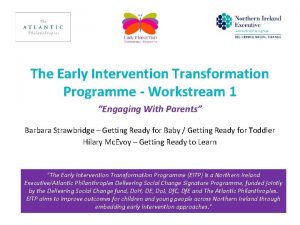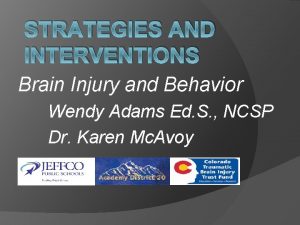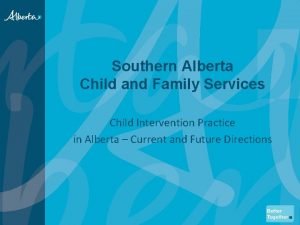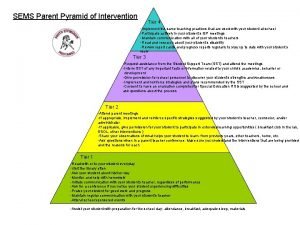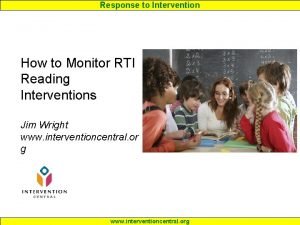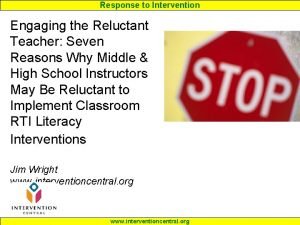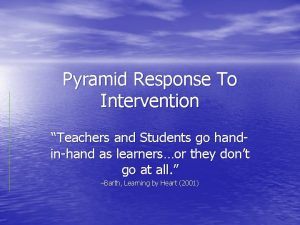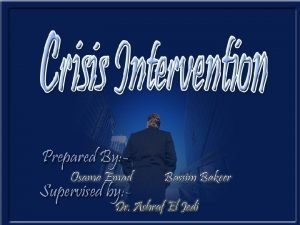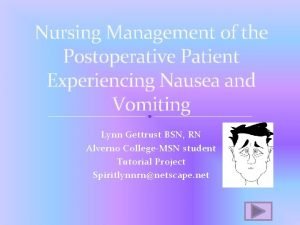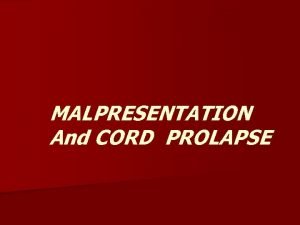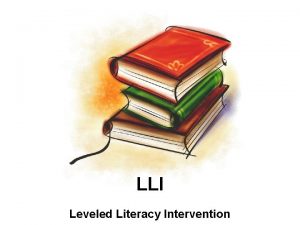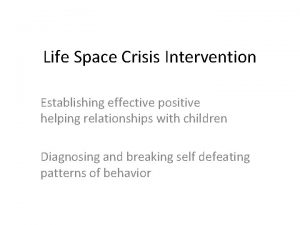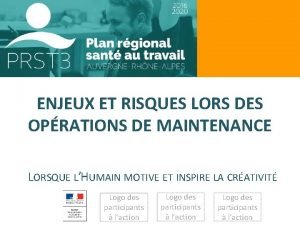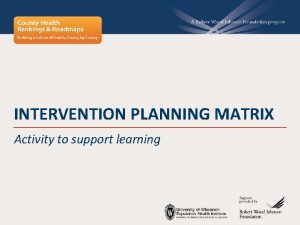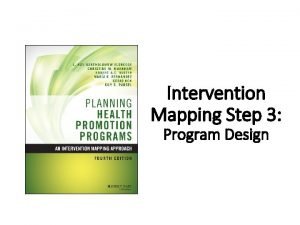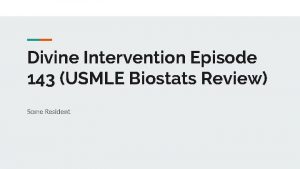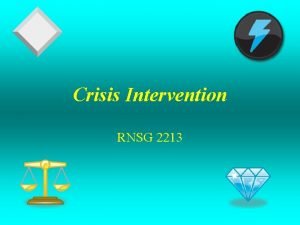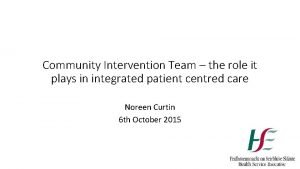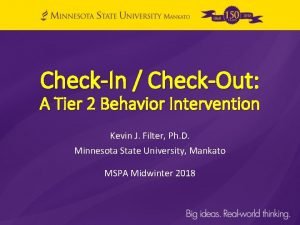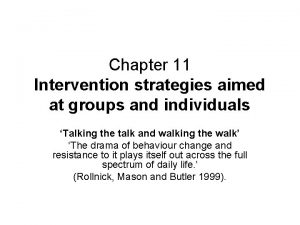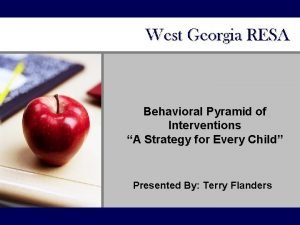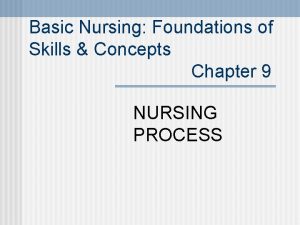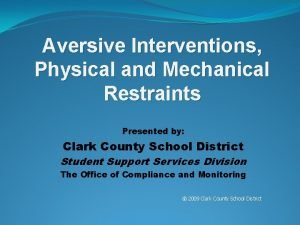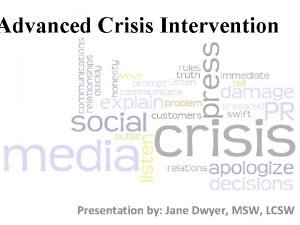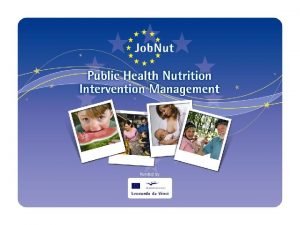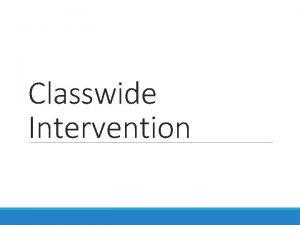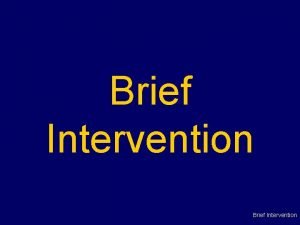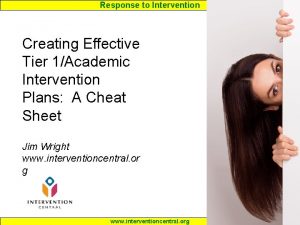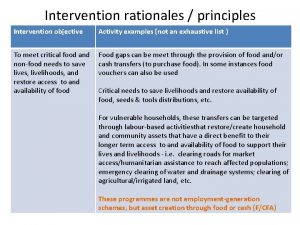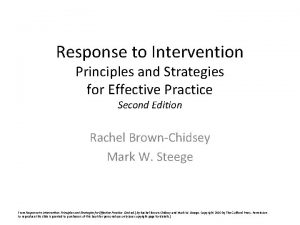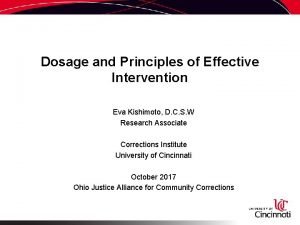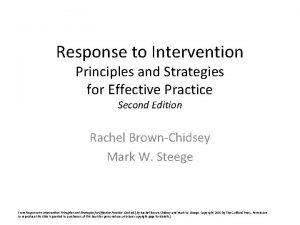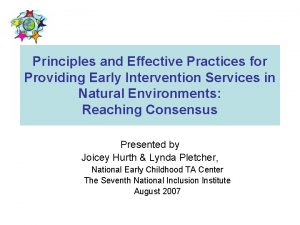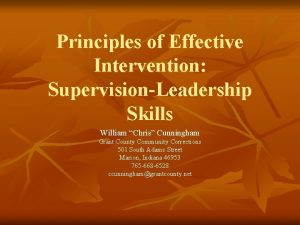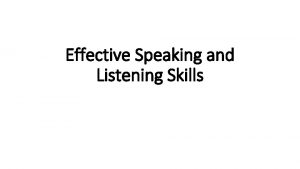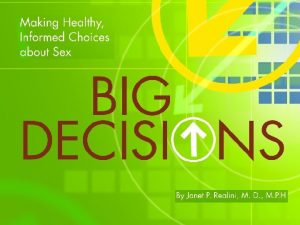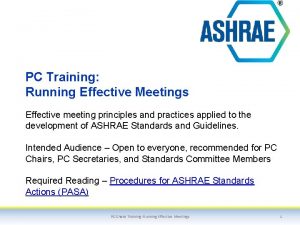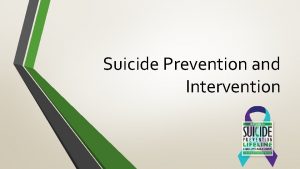Understanding the Principles of Effective Intervention and the




























































































































- Slides: 124

Understanding the Principles of Effective Intervention and the Importance of Using and Applying Risk Assessment Presented by: Edward J. Latessa, Ph. D. School of Criminal Justice University of Cincinnati Edward. Latessa@uc. edu www. uc. edu/criminaljustice

Evidence Based – What does it mean? There are different forms of evidence: – The lowest form is anecdotal evidence; stories, opinions, testimonials, case studies, etc - but it often makes us feel good – The highest form is empirical evidence – research, data, results from controlled studies, etc. - but sometimes it doesn’t make us feel good

Evidence Based Practice is: 1. Easier to think of as Evidence Based Decision Making 2. Involves several steps and encourages the use of validated tools and treatments. 3. Not just about the tools you have but also how you use them

Evidence-Based Decision Making Requires 1. Assessment information - Valid and reliable offenders assessment process - Assessment of programs and practices 2. Relevant research - Consult research - Design and fund programs that are based on empirical evidence - Use existing resources (i. e. , Crimesolutions. gov) 3. Available programming - To reduce risk - Improve existing programs - Develop new programs

Evidence-Based Decision Making Requires: 4. Evaluation - Offenders - Quality assurance processes - Performance measures - Data 5. Professionalism and knowledge from staff - Understand EBP - Trained, coached, and skilled - Commitment

A Large Body of Research Has Indicated…. …. that correctional services and interventions can be effective in reducing recidivism for offenders, however, not all programs are equally effective • The most effective programs are based on some principles of effective interventions • Risk (Who) • Need (What) • Treatment (How) • Program Integrity (How Well)

Let’s Start with the Risk Principle Risk refers to risk of reoffending and not the seriousness of the offense.

Risk Principle As a general rule treatment effects are stronger if we target higher risk offenders, and harm can be done to low risk offenders

Percent with New Arrest Risk Level by Recidivism for the Community Supervision Sample Low 0 -14 Medium = 15 -23 High = 24 -33 Very High 34+

There are Three Elements to the Risk Principle 1. Target those offenders with higher probability of recidivism 2. Provide most intensive treatment to higher risk offenders 3. Intensive treatment for lower risk offender can increase recidivism

#1: Targeting Higher Risk Offenders • It is important to understand that even with EBP there will be failures. • Even if you reduce recidivism rates you will still have high percentage of failures

Example of Targeting Higher Risk Offenders • If you have 100 High risk offenders about 60% will fail • If you put them in well designed EBP for sufficient duration you may reduce failure rate to 40% • If you have 100 low risk offenders about 10% will fail • If you put them in same program failure rate will be 20%

Targeting Higher Risk Offenders continued: • In the end, who had the lower recidivism rate? • Mistake we make is comparing high risk to low risk rather than look for treatment effects

#2: Provide Most Intensive Interventions to Higher Risk Offenders

The question is: What does more “intensive” treatment mean in practice? • Most studies show that the longer someone is in treatment the great the effects, however: • Effects tend to diminish if treatment goes too long

Results from a 2010 Study (Latessa, Sperber, and Makarios) of 689 offenders • • 100 -bed secure residential facility for adult male offenders Cognitive-behavioral treatment modality Average 33 60% single, never married 43% less than high school education 80% moderate risk or higher 88% have probability of substance abuse per SASSI

2010 Dosage Study of 689 Offenders Sperber, , Latessa & Makarios (2013). Examining the Interaction between Level of Risk and Dosage of Treatment. Criminal Justice and Behavior, 40(3).

Findings • We saw large decreases in recidivism when dosage levels go from 100 to 200 hours for high risk offenders---81% to 57%. • The results are not as strong for moderate risk offenders

Results from 2014 Study • We expanded sample • Hours examined by increments of 50 • Looked at low/moderate, and high

2014 Dosage Study involving 903 offenders Makarios, Sperber, & Latessa (2014). Treatment Dosage and the Risk Principle: A Refinement and Extension. Journal of Offender Rehabilitation. 53: 334 -350.

Provide Most Intensive Interventions to Higher Risk Offenders • Higher risk offenders will require much higher dosage of treatment – Rule of thumb: 100 -150 hours for moderate risk – 200+ hours for high risk – 100 hours for high risk will have little effect – Does not include work/school and other activities that are not directly addressing criminogenic risk factors

#3: Intensive Treatment for Low Risk Offenders will Often Increase Failure Rates • Low risk offenders will learn anti social behavior from higher risk • Disrupts pro-social networks • Increased reporting/surveillance leads to more violations/revocations

Study of Intensive Rehabilitation Supervision in Canada Recidivism Rates Bonta, J et al. , 2000. A Quasi-Experimental Evaluation of an Intensive Rehabilitation Supervision Program. , Vol. 27 No 3: 312 -329. Criminal Justice and Behavior

STUDY OF COMMUNITY CORRECTIONAL PROGRAMS IN OHIO • Largest study of community based correctional treatment facilities ever done up to that time. • Total of 13, 221 offenders – 37 Halfway Houses and 15 Community Based Correctional Facilities (CBCFs) were included in the study. • Two-year follow-up conducted on all offenders • Recidivism measures included new arrests & incarceration in a state penal institution Lowenkamp, C. T. & Latessa, E. J. (2002). Evaluation of Ohio’s Community Based Correctional Facilities and Halfway House Programs. Cincinnati, Ohio: Division of Criminal Justice, University of Cincinnati.

Reduced Recidivism Increased Recidivism


2010 STUDY OF COMMUNITY CORRECTIONAL PROGRAMS IN OHIO • Over 20, 000 offenders – 44 Halfway Houses and 20 Community Based Correctional Facilities (CBCFs) were included in the study. • Two-year follow-up conducted on all offenders Latessa, E. , Lovins, L. , & Smith, P. (2010). Follow-up Evaluation of Ohio’s Community Based Correctional Facility and Halfway House Programs— Outcome Study. Cincinnati, Ohio: School of Criminal Justice, University of Cincinnati.

-60 Harbor Light--D/A Comp. Drug MONDAY Oriana RIP Oriana CCTC West Central CATS male RTP TH Turtle Creek Cinti VOA SOT AH Alum Creek Harbor Light--Corr Alternatives Franklin STARK WORTH CTCC Canton NEOCAP Oriana TMRC TH Springrove Oriana Summit Pathfinder Oriana Cliff Skeen ALL CBCF FACILITIES EOCC Female ALL HWH FACILITIES Lorain-Medina Mahoning Oriana Crossweah River City STAR Talbert House CCC Booth H/Salv A CCA RTC II Cinti VOA D/A Comm Trans Ctr Crossroads Diversified Fresh Start SOS TH Pathways AH Dunning ARCA Oriana RCC Licking-Muskingum CATS female RTP Mansfield VOA SEPTA TH Cornerstone EOCC Male Lucas AH Price AH Veterans Dayton VOA Small Programs Toledo VOA Northwest CCC TH Beekman CATS male TC % Difference in Rate of New Felony Conviction Treatment Effects for Low Risk 60 50 40 30 20 10 0 -10 -20 -30 -40 -50

-60 AH Veterans TH Beekman MONDAY CTCC Canton TH Springrove Northwest CCC WORTH Diversified Oriana CCTC Oriana Summit Oriana Crossweah ARCA Booth H/Salv A CATS male RTP Crossroads Franklin Comm Trans Ctr STARK River City Talbert House CCC West Central EOCC Male ALL CBCF FACILITIES Comp. Drug AH Dunning Alternatives CCA RTC II Small Programs Harbor Light--D/A ALL HWH FACILITIES Oriana TMRC CATS male TC Fresh Start Dayton VOA NEOCAP Harbor Light--Corr Oriana RIP Licking-Muskingum Mahoning Cinti VOA D/A Oriana RCC STAR SOS Lucas CATS female RTP AH Price TH Turtle Creek Lorain-Medina Pathfinder Toledo VOA EOCC Female Oriana Cliff Skeen SEPTA AH Alum Creek Mansfield VOA TH Cornerstone CCA RTC I % Difference in Rate of New Felony Conviction Treatment Effects for High Risk 60 50 40 30 20 10 0 -10 -20 -30 -40 -50

To understand the Need Principle we need to review the body of knowledge related to risk factors What are the risk factors correlated with criminal conduct?

Major Set of Risk/Need Factors 1. Antisocial/procriminal attitudes, values, beliefs and cognitive-emotional states

Cognitive Emotional States • • Rage Anger Defiance Criminal Identity

Identifying Procriminal Attitudes, Values & Beliefs Procriminal sentiments are what people think, not how people think; they comprise the content of thought, not the skills of thinking. What to listen for: • Negative expression about the law • Negative expression about conventional institutions, values, rules, & procedures; including authority • Negative expressions about self-management of behavior; including problem solving ability • Negative attitudes toward self and one’s ability to achieve through conventional means • Lack of empathy and sensitivity toward others

Neutralization & Minimizations Offenders often neutralize their behavior. Neutralizations are a set of verbalizations which function to say that in particular situations, it is “OK” to violate the law Neutralization Techniques include: • Denial of Responsibility: Criminal acts are due to factors beyond the control of the individual, thus, the individual is guilt free to act. • Denial of Injury: Admits responsibility for the act, but minimizes the extent of harm or denies any harm • Denial of the Victim: Reverses the role of offender & victim & blames the victim • “System Bashing”: Those who disapprove of the offender’s acts are defined as immoral, hypocritical, or criminal themselves. • Appeal to Higher Loyalties: “Live by a different code” – the demands of larger society are sacrificed for the demands of more immediate loyalties. (Sykes and Maltz, 1957)

Major set Risk/needs continued: 2. Procriminal associates and isolation from prosocial others

Reducing Negative Peer Associations ü Restrict associates ü Set and enforce curfews ü Ban hangouts, etc. ü Teach offender to recognize & avoid negative influences (people, places, things) ü Practice new skills (like being assertive instead of passive) ü Teach how to maintain relationships w/o getting into trouble ü Identify or develop positive associations: mentors, family, friends, teachers, employer, etc. ü Train family and friends to assist offender ü Set goal of one new friend (positive association) per month ü Develop sober/prosocial leisure activities

Major set Risk/Needs continued: 3. Temperamental & anti social personality pattern conducive to criminal activity including: – – – – – Weak Socialization Impulsivity Adventurous Pleasure seeking Restless Aggressive Egocentrism Below Average Verbal intelligence A Taste For Risk Weak Problem-Solving/lack of Coping & Self-Regulation Skills

Major set of Risk/Need factors continued: 4. A history of antisocial behavior: – Evident from a young age – In a variety of settings – Involving a number and variety of different acts

Major set of Risk/Needs Continued: 5. Family factors that include criminality and a variety of psychological problems in the family of origin including: – Low levels of affection, caring and cohesiveness – Poor parental supervision and discipline practices – Out right neglect and abuse

Major set of Risk/Needs continued: 6. Low levels of personal educational, vocational or financial achievement

Leisure and/or recreation 7. Low levels of involvement in prosocial leisure activities – Allows for interaction with antisocial peers – Allows for offenders to have idle time – Offenders replace prosocial behavior with antisocial behavior

Substance Abuse 8. Abuse of alcohol and/or drugs –It is illegal itself (drugs) –Engages with antisocial others –Impacts social skills

Major Risk and/or Need Factor and Promising Intermediate Targets for Reduced Recidivism Factor Risk Dynamic Need History of Antisocial Behavior Early & continued involvement in a number antisocial acts Build noncriminal alternative behaviors in risky situations Antisocial personality Adventurous, pleasure Build problem-solving, selfseeking, weak self management, anger mgt & control, restlessly aggressive coping skills Antisocial cognition Attitudes, values, beliefs & rationalizations supportive of crime, cognitive emotional states of anger, resentment, & defiance Reduce antisocial cognition, recognize risky thinking & feelings, build up alternative less risky thinking & feelings Adopt a reform and/or anticriminal identity Antisocial associates Close association with criminals & relative isolation from prosocial people Reduce association w/ criminals, enhance association w/ prosocial people Adopted from Andrews, D. A. et al, (2006). The Recent Past and Near Future of Risk and/or Need Assessment. Crime and Delinquency, 52 (1).

Major Risk and/or Need Factor and Promising Intermediate Targets for Reduced Recidivism Factor Risk Dynamic Need Family and/or marital Two key elements are nurturance and/or caring better monitoring and/or supervision Reduce conflict, build positive relationships, communication, enhance monitoring & supervision School and/or work Low levels of performance Enhance performance, & satisfaction rewards, & satisfaction Leisure and/or recreation Low levels of involvement Enhance involvement & satisfaction in anti- & satisfaction in prosocial criminal leisure activities Substance Abuse of alcohol and/or drugs Reduce SA, reduce the personal & interpersonal supports for SA behavior, enhance alternatives to SA Adopted from Andrews, D. A. et al, (2006). The Recent Past and Near Future of Risk and/or Need Assessment. Crime and Delinquency, 52 (1).

Mentally Disordered Offenders (MDOs) Conventional Clinical Wisdom: • Criminal activities of MDOs best explained by psychopathological models • Assessments typically focus on psychiatric diagnoses, psychiatric symptomatology, and personal distress (i. e. anxiety, depression) • Assessments are often costly and time consuming

MDOs Continued Review of the Empirical Research: • The Psychopathological model has little relevance regarding the prediction of MDO criminal behavior • Gendreau (1996) conducted meta-analysis on studies of psychiatric symptomatology and general recidivism: Correlation=ZERO • Bonta’s (1998) meta analysis found correlation between having a diagnosed mental disorder, mood disorder, or psychosis and general/violent recidivism ranged from r =. 01 to -. 17. • Criminogenic risk factors were the strongest predictors (r=. 23) • Major correlates of criminal behavior appear to be the same regardless of presence or absence of a mental disorder

Average Effect Size of Risk Factors with General & Violent Recidivism Bonta, Blais and Wilson (2014) A theoretically informed meta-analysis of the risk for general and violent recidivism for mentally disordered offenders. Aggression and Violent Behavior, 19 : 278 -287.

Average Effect Size of Clinical Factors with General & Violent Recidivism Bonta, Blais and Wilson (2014) A theoretically informed meta-analysis of the risk for general and violent recidivism for mentally disordered offenders. Aggression and Violent Behavior, 19: 278 -287.

Study by Bucklen and Zajac of parole violators in Pennsylvania found a number of criminogenic factors related to failure* *Bucklen, B. , & Zajac, G. (2009). But some of them don’t come back (to prison!): Resource deprivation and thinking errors as determinants of parole success and failure. The Prison Journal. 89: 239– 264.

Pennsylvania Parole Study Social Network and Living Arrangements Violators Were: • More likely to hang around with individuals with criminal backgrounds • Less likely to live with a spouse • Less likely to be in a stable supportive relationship • Less likely to identify someone in their life who served in a mentoring capacity

Pennsylvania Parole Study Employment & Financial Situation Violators were: • Only slightly more likely to report having difficulty getting a job • Less likely to have job stability • Less likely to be satisfied with employment • Less likely to take low end jobs and work up • More likely to have negative attitudes toward employment & unrealistic job expectations • Less likely to have a bank account • More likely to report that they were “barely making it” (yet success group reported over double median debt)

Pennsylvania Parole Study Alcohol or Drug Use Violators were: • More likely to report use of alcohol or drugs while on parole (but no difference in prior assessment of dependency problem) • Poor management of stress was a primary contributing factor to relapse

Pennsylvania Parole Study Life on Parole - Violators were: • • • Had poor problem solving or coping skills Did not anticipate long term consequences of behavior Failed to utilize resources to help themselves Acted impulsively to immediate situations Felt they were not in control More likely to maintain anti-social attitudes Viewed violations as an acceptable option to situation Maintained general lack of empathy Shifted blame or denied responsibility Had unrealistic expectations about what life would be like outside of prison

Pennsylvania Parole Violator Study: • Successes and failures did not differ in difficulty in finding a place to live after release • Successes & failures equally likely to report eventually obtaining a job

Need Principle By assessing and targeting criminogenic needs for change, agencies can reduce the probability of recidivism Criminogenic Non-Criminogenic • • • Anti social attitudes Anti social friends Substance abuse Lack of empathy Impulsive behavior Anxiety Low self esteem Creative abilities Medical needs Physical conditioning

Targeting Criminogenic Need: Results from Meta. Analyses Reduction in Recidivism Increase in Recidivism Source: Gendreau, P. , French, S. A. , and A. Taylor (2002). What Works (What Doesn’t Work) Revised 2002. Invited Submission to the International Community Corrections Association Monograph Series Project

Criminal Thinking and Mental Illness* Morgan, Fisher and Wolff (2010) studied 414 adult offenders with mental illness (265 males, 149 females) and found: • 66% had belief systems supportive of criminal life style (based on Psychological Inventory of Criminal Thinking Scale (PICTS) • When compare to other offender samples, male offenders with MI scored similar or higher than non-mentally disordered offenders. • On Criminal Sentiments Scale-Revised, 85 % of men and 72 % of women with MI had antisocial attitudes, values and beliefs – which was higher than incarcerated sample without MI. Center for Behavioral Health Services Criminal Justice Research Policy Brief, April 2010. Rutgers University.

Conclusion • Criminal Thinking styles differentiate people who commit crimes from those who do not independent of mental illness • Incarcerated persons with mental illness are often mentally ill and criminal • Needs to be treated as co-occurring problems

Assessment is the engine that drives effective correctional programs • Need to meet the risk and need principle • Can help reduces bias • Aids decision making • Allows you to target dynamic risk factors and measure change • Best risk assessment method is the actuarial (statistical) approach

Comparison of Clinical vs. Statistical Prediction of Recidivism

Comparison of Clinical vs. Statistical Prediction of Sex Offenders

To Understand Assessment it is Important to Understand Types of Risk Factors

Dynamic and Static Factors • Static Factors are those factors that are related to risk and do not change. Some examples might be number of prior offenses, whether an offender has ever had a drug/alcohol problem. • Dynamic factors relate to risk and can change. Some examples are whether an offender is currently unemployed or currently has a drug/alcohol problem.

According to the American Heart Association, there a number of risk factors that increase your chances of a first heart attack ü Family history of heart attacks ü Gender (males) ü Age (over 50) ü Inactive lifestyle ü Over weight ü High blood pressure ü Smoking ü High Cholesterol level

There are two types of dynamic risk factors • Acute – Can change quickly • Stable – Take longer to change

Some Examples of Offender Risk Assessment Tools • • • Level of Service Inventory (LSI) COMPAS PCL Wisconsin Risk Needs Ohio Risk Assessment System

One New Non-Proprietary System is the ORAS The Ohio Risk Assessment System (ORAS) consists of 6 basic tools: 1. Pre-Trial Tool (ORAS-PAT) 2. Misdemeanor Assessment Tool (ORAS-MAT) 3. Community Supervision Assessment Tool (ORAS-CST) 4. Prison Intake Tool (ORAS-PIT) 5. Reentry Tool (ORAS-RT) 6. Supplemental Reentry Tool (ORAS-SRT) Screening tools are available for the MAT, CST and PIT.

Community Supervision Risk Assessment Tool (ORAS-CST)

Final Domains on the ORAS-CST 1. 2. 3. 4. 5. 6. 7. Criminal /Supervision History (6 items) Education, Employment and Finances(6 items) Family and Social Support (5 items) Neighborhood Problems (2 items) Substance Use (5 items) Peer Associations (4 items) Criminal Attitudes and Behavioral Problems (7 items)

ORAS-CST Intake Assessment

Percent with New Arrest Males: Risk Level by Recidivism for the Community Supervision Sample Low 0 -14 Medium = 15 -23 High = 24 -33 Very High 34+ ORAS-CST Risk Level Correlation with Recidivism: r =. 373

Percent with New Arrest Females: Risk Level by Recidivism for the Community Supervision Sample Low 0 -14 Medium 15 -21 High 22 -28 Very High 29+ ORAS-CST Risk Level Correlation with Recidivism: r =. 300

ORAS-CST Re-assessment Peer Association

Prioritizing Targets for Change Staff can prioritize the needs of offenders based on time, risk level, or available resources

Prison Reentry Assessment Tool (ORAS-RT) The RT is used for inmates that have been incarcerated 4 years or longer

Final Domains in the ORAS-RT 1. 2. 3. Criminal /Supervision History (8 items) Social Capital and Support (5 items) Criminal Attitudes and Behavioral Patterns (7 items)

Percent with New Arrest Males: Risk Level by Recidivism for the Prison Release Sample Low 0 -9 Medium 10 -15 High 16+ ORAS-PRT Risk Level Correlation with Recidivism: r =. 295

Percent with New Arrest Females: Risk Level by Recidivism for the Prison Release Sample Low 0 -10 Medium = 11 -14 High = 15+ ORAS-PRT Risk Level Correlation with Recidivism: r =. 442

ORAS-SRT Supplemental Reentry Tool The SRT is used for those who have been incarcerated for less than 4 years and are returning to the community

Final Domains for the Prison Supplemental Reentry Assessment 1. 2. 3. 4. Criminal History (8 items) Education, Employment, and Social Support (7 items) Substance Abuse and Mental Health (4 items) Criminal Attitudes and Behavioral Patterns (12 items)

Risk Level by Recidivism for the Supplemental Reentry Tool Sample

Use of the ORAS • Non-Proprietary System • Training and Training of Trainers is Available • Automated system is available

ORAS Locations (Current and Upcoming) • Alabama • California: – Monterey County – Ventura County – Yolo County – Calaveras Co • Colorado • Connecticut • Florida: – – Alachua County Orange County Osceola County Seminole County • Kansas City • Indiana (IRAS) • Montana • Pennsylvania – Dauphin County – York County • Ohio • Oklahoma • Texas (T-RAS) they recently conducted a validation study) • Vermont • New Hampshire

Some Common Problems with Offender Assessment Ø Don’t assess offenders at all Ø Assess offenders but process ignores important factors Ø Assess offenders but don’t distinguish levels (high, moderate, low) Ø Assess offenders then don’t use it – everyone gets the same treatment Ø Make errors and don’t correct Ø Do not adequately train staff in use or interpretation Ø Assessment instruments are not validated or normed Ø No quality assurance in place

Maximizing the Assessment Process • View assessment as a process not a “one time” activity • Develop a flexible process that expands as needed • Standardize process and instruments • Make sure the assessment is accurate & correct errors • Make sure staff correctly interpret the results • Develop case supervision & treatment plan from the assessment results • Audit assessments on a regular basis • Train and retrain staff • Assign offenders to programs/groups based on assessment information • Share information with service providers • Reassess offenders periodically • Collect data & analyze • Periodically validate instruments with your population

Some things to remember • There is no “one size fits all” assessment tool – some domains or types of offenders will require specialized assessments (such as sex offenders) – use or purpose will vary • Actuarial assessment is more accurate than clinical assessment, but no process is perfect • Assessment helps guide decisions, doesn’t make them -professional discretion is part of good assessment • Reliability is more difficult to achieve with dynamic instruments – requires training of staff and continual monitoring of assessment process

The Treatment Principle (aka Responsivity) • General – Most offenders respond to programs that are based on cognitive behavioral/social learning theories • Specific – Offenders learn differently and have certain barriers that should be addressed so that they are more likely to succeed in programs

Specific Responsivity What gets in the way of offenders benefiting from treatment? – Must take individual learning styles into account – Must consider possible barriers to interventions – Assessment and addressing responsivity factors can be important to maximize benefits of treatment

Assessing Specific Responsivity Factors • Often neglected • Can be useful in assigning offenders to programs and groups • Addressing responsivity factors can improve treatment effectiveness

Responsivity areas to assess can include: • • • Motivation to change Anxiety/psychopathy Levels of psychological development Maturity Cognitive functioning Mental disorders

Prioritizing Interventions: What to Change and Why • Criminogenic targets – reduce risk for recidivism • Non-criminogenic targets (such as responsivity) – may reduce barriers but NOT risk

Treatment Principle (general responsivity) The most effective interventions are behavioral: • Focus on current factors that influence behavior • Action oriented • Staff follow “core correctional practices”

Results from Meta Analysis: Behavioral vs. Non. Behavioral Reduced Recidivism Andrews, D. A. 1994. An Overview of Treatment Effectiveness. Research and Clinical Principles, Department of Psychology, Carleton University. The N refers to the number of studies.

Most Effective Behavioral Models • Structured social learning where new skills and behaviors are modeled • Cognitive behavioral approaches that target criminogenic risk factors

Social Learning Refers to several processes through which individuals acquire attitudes, behavior, or knowledge from the persons around them. Both modeling and instrumental conditioning appear to play a role in such learning

The Four Principles of Cognitive Intervention 1. Thinking affects behavior 2. Antisocial, distorted, unproductive irrational thinking can lead to antisocial and unproductive behavior 3. Thinking can be influenced 4. We can change how we feel and behave by changing what we think

Reasons that CBT can be Effective in Reducing Recidivism 1. Based on scientific evidence (cognitive & behavioral theories) 2. Based on active learning (not talk therapy) 3. Focus on the present (how offenders currently think and behave) 4. Based on learning (most crime is learned) 5. Target major criminogenic needs (e. g. attitudes, values, beliefs) 6. Provides structure to groups and programs (manualized treatment)

Reasons that CBT is Popular in Corrections • • Can be done in any setting Existing staff can be trained on CBT Relatively cheap to deliver Wide range of curriculums are available

Recent Meta-Analysis of Cognitive Behavioral Treatment for Offenders by Landenberger & Lipsey (2005)* • Reviewed 58 studies: 19 random samples 23 matched samples 16 convenience samples • Found that on average CBT reduced recidivism by 25%, but the most effective configurations found more than 50% reductions

Significant Findings (effects were stronger if): • • Sessions per week (2 or more) - RISK Implementation monitored - FIDELITY Staff trained on CBT - FIDELITY Higher proportion of treatment completers RESPONSIVITY • Higher risk offenders - RISK • Higher if CBT is combined with other services - NEED

Core Correctional Practices 1. 2. 3. 4. 5. 6. 7. 8. Effective Reinforcement Effective Disapproval Effective Use of Authority Quality Interpersonal Relationships Cognitive Restructuring Anti-criminal Modeling Structured Learning/Skill Building Problem Solving Techniques

Core Correctional Practices and Recidivism Effect Size Gendreau (2003). Invited Address. APA Annual Conference. Toronto.

Ratio of Rewards to Punishments and Probability of Success on Intensive Supervision 90% Probability of ISP Success 80% 70% 60% 50% 40% 30% 20% 10% 0% 1: 10 1: 08 1: 06 1: 04 1: 02 2: 01 4: 01 6: 01 Ratio of Rewards to Punishments 8: 01 10: 01 Widahl, E. J. , Garland, B. Culhane, S. E. , and Mc. Carty, W. P. (2011). Utilizing Behavioral Interventions to Improve Supervision Outcomes in Community-Based Corrections. Criminal Justice and Behavior, 38 (4).

List of Rewards and Sanctions • • • Verbal reprimand Written assignment Modify curfew hours Community service hours Restrict visitation Program extension or regression Electronic Monitoring Inpatient or outpatient txt Detention time Rewards • Verbal praise and reinforcement • Remove from EM • Level advancement • Increased personal time • Approved special activity • Fees reduced • Approve of extend special visitation Widahl, E. J. , Garland, B. Culhane, S. E. , and Mc. Carty, W. P. (2011). Utilizing Behavioral Interventions to Improve Supervision Outcomes in Community-Based Corrections. Criminal Justice and Behavior, 38 (4).

Sanction Type by Offender Compliance Wadahl, Boman and Garland (2015) examined 283 offenders on ISP and looked at the effectiveness of jail time versus community-based sanctions. Widahl, E. J. , Boman, J. H. and Garland, B. E. . (2015). Responding to Probation and Parole Violations: Are Jail Sanctions more Effective than Community-based Graduated Sanctions? Journal of Criminal Justice, 43: 243 -250.

List of Sanctions Verbal reprimand Written assignment Modify curfew hours Community service hours Restrict visitation Program extension or regression Electronic Monitoring Inpatient or outpatient txt County jail time Widahl, E. J. , Boman, J. H. and Garland, B. E. . (2015). Responding to Probation and Parole Violations: Are Jail Sanctions more Effective than Community-based Graduated Sanctions? Journal of Criminal Justice, 43: 243 -250.

They found Jail Time: • Was not related to number of days until the next violation • Did not increase or decrease the number of subsequent violations • Receiving jail time as a sanction as opposed to a community-based sanction did not influence successful completion of supervision

We are currently training on a new model of PO and Case Manger interaction Effective Practices in Correctional Supervision (EPICS) 109

Traditional Officer-Offender Interactions are often not Effective because: q They are too brief to have an impact q Conversations focus almost exclusively on monitoring compliance conditions (and therefore emphasize external controls on behavior rather than developing an internal rationale for pro-social behavior) q Relationship is often more confrontational and authoritarian in nature than helpful q What is targeted is not always based on assessment q More areas discussed=less effective 110

Rationale for EPICS Preliminary Data from Canada: q. Trained officers had 12% higher retention rates in comparison with untrained officers at six months. q. Also found reductions in recidivism 111

Two year Recidivism Results from Canadian Study Bont, et al, (2010) The Strategic Training Initiative in Community Suopervision: Risk-Need-Responsivity in the Real World. Public Safety Canada.

Findings from Federal Probation Sample Robinson, Vanbenschoten, Alexander, and Lowenkamp, Federal Probation, Sept. 2011.

Recidivism Results from Ohio Study looking at Fidelity and High Risk Offenders (adult and juvenile) Latessa, E. , Smith, P. , Schweitzer, m. , and Labrecque, R. (2013). Evaluation of the Effective Practices in Community Supervision Model (EPICS) in Ohio. School of Criminal Justice, University of Cincinnati.

EPICS • Helps bring together all of your EBP efforts: – – – – Risk assessment and priority on higher risk offenders Focus on criminogenic needs Takes motivational interviewing to the next level Supports programs and services Helps PO become a more effective agent of change Increases compliance Reduces recidivism

We are Currently Piloting a New Version: Effective Practices for Community Support (EPICS for Influencers) • Designed to identify those people in the offender’s life that want to help them stay out of trouble and train them on some of the core skills taught in EPICS. • Includes training of coaches to provide on-going support

Why EPICS for Influencers? • Build a pro-social network with some actual skills to help offenders avoid risky situations • Increase “dosage” • Research shows that relapse prevention programs that trained significant others and family members in cognitive-behavioral approaches were three times as effective as programs that did not.

EPICS for Influencers is Designed for: • • • Mentors Coaches Family Members Friends Faith Based Organizations Reentry Coalitions Law Enforcement School Officials Significant others

EPICS for Influencers Pilot Sites include: • LA County Jail Reentry Program • Hamilton County (Cincinnati) Reentry Coalition • Portsmouth, OH Juvenile Truancy and Mentoring Program

These approaches help us…. • Structure our interventions • Teach and model new skills • Allow offender to practice with graduated difficulty • Reinforce the behavior

What Doesn’t Work with Offenders?

Lakota tribal wisdom says that when you discover you are riding a dead horse, the best strategy is to dismount. However, in corrections, and in other affairs, we often try other strategies, including the following: • • • Buy a stronger whip. Change riders Say things like “This is the way we always have ridden this horse. ” Appoint a committee to study the horse. Arrange to visit other sites to see how they ride dead horses. Create a training session to increase our riding ability. Harness several dead horses together for increased speed. Declare that “No horse is too dead to beat. ” Provide additional funding to increase the horse’s performance. Declare the horse is “better, faster, and cheaper” dead. Study alternative uses for dead horses. Promote the dead horse to a supervisory position.

Ineffective Approaches with Offenders • Programs that cannot maintain fidelity • Programs that target non-criminogenic needs • Drug prevention classes focused on fear and other emotional appeals • Shaming offenders • Drug education programs • Non-directive, client centered approaches • Bibliotherapy • Talking cures • Self-Help programs • Vague unstructured rehabilitation programs • “Punishing smarter” (boot camps, scared straight, etc. )

Fidelity Principle Making sure the program is delivered as designed and with integrity: • Ensure staff are modeling appropriate behavior, are qualified, well trained, well supervision, etc. • Make sure barriers are addressed but target criminogenic needs • Make sure appropriate dosage of treatment is provided • Monitor delivery of programs & activities, etc. • Reassess offenders in meeting target behaviors

Some Lessons Learned from the Research Ø Who you put in a program is important – pay attention to risk Ø What you target is important – pay attention to criminogenic needs Ø How you target offender for change is important – use behavioral approaches Ø Program Integrity makes a difference - Service delivery, training/supervision of staff, support for program, QA, evaluation, etc.
 Principles of effective intervention
Principles of effective intervention Understanding behaviors for effective leadership
Understanding behaviors for effective leadership Motion study involves analysis of
Motion study involves analysis of National integration and international understanding
National integration and international understanding Principles of effective teamwork
Principles of effective teamwork Principles of effective advertising
Principles of effective advertising Principles of effective practice
Principles of effective practice Prinsip penulisan surat
Prinsip penulisan surat Principles of effective leadership in virtual teams
Principles of effective leadership in virtual teams Principles of effective writing
Principles of effective writing 11 principles of effective character education
11 principles of effective character education Principles of effective planning
Principles of effective planning Color 09152004
Color 09152004 Chapter 8 principles of effective documentation
Chapter 8 principles of effective documentation 10 principles of effective online teaching
10 principles of effective online teaching Basic principles of effective portfolio management
Basic principles of effective portfolio management Principles of communication correctness
Principles of communication correctness Principles of effective training
Principles of effective training Effective writing examples
Effective writing examples Sender, receiver, occasion and tasks are:
Sender, receiver, occasion and tasks are: Principle of effective communication
Principle of effective communication Principles of drug addiction treatment
Principles of drug addiction treatment Find the measures of the numbered angles in rhombus defg
Find the measures of the numbered angles in rhombus defg National programmes related to nutrition
National programmes related to nutrition Early warning intervention and monitoring system
Early warning intervention and monitoring system Child youth and family intervention courses
Child youth and family intervention courses Producer surplus tax
Producer surplus tax Check-in/check-out intervention template
Check-in/check-out intervention template School crisis prevention and intervention
School crisis prevention and intervention Petition and intercession prayer example
Petition and intercession prayer example 11-1 areas of parallelograms
11-1 areas of parallelograms Hybrid model of crisis intervention
Hybrid model of crisis intervention Hát kết hợp bộ gõ cơ thể
Hát kết hợp bộ gõ cơ thể Frameset trong html5
Frameset trong html5 Bổ thể
Bổ thể Tỉ lệ cơ thể trẻ em
Tỉ lệ cơ thể trẻ em Gấu đi như thế nào
Gấu đi như thế nào Thang điểm glasgow
Thang điểm glasgow Hát lên người ơi
Hát lên người ơi Các môn thể thao bắt đầu bằng tiếng nhảy
Các môn thể thao bắt đầu bằng tiếng nhảy Thế nào là hệ số cao nhất
Thế nào là hệ số cao nhất Các châu lục và đại dương trên thế giới
Các châu lục và đại dương trên thế giới Công thức tính thế năng
Công thức tính thế năng Trời xanh đây là của chúng ta thể thơ
Trời xanh đây là của chúng ta thể thơ Mật thư anh em như thể tay chân
Mật thư anh em như thể tay chân 101012 bằng
101012 bằng độ dài liên kết
độ dài liên kết Các châu lục và đại dương trên thế giới
Các châu lục và đại dương trên thế giới Thể thơ truyền thống
Thể thơ truyền thống Quá trình desamine hóa có thể tạo ra
Quá trình desamine hóa có thể tạo ra Một số thể thơ truyền thống
Một số thể thơ truyền thống Cái miệng nó xinh thế chỉ nói điều hay thôi
Cái miệng nó xinh thế chỉ nói điều hay thôi Vẽ hình chiếu vuông góc của vật thể sau
Vẽ hình chiếu vuông góc của vật thể sau Biện pháp chống mỏi cơ
Biện pháp chống mỏi cơ đặc điểm cơ thể của người tối cổ
đặc điểm cơ thể của người tối cổ V. c c
V. c c Vẽ hình chiếu đứng bằng cạnh của vật thể
Vẽ hình chiếu đứng bằng cạnh của vật thể Tia chieu sa te
Tia chieu sa te Thẻ vin
Thẻ vin đại từ thay thế
đại từ thay thế điện thế nghỉ
điện thế nghỉ Tư thế ngồi viết
Tư thế ngồi viết Diễn thế sinh thái là
Diễn thế sinh thái là Dot
Dot Bảng số nguyên tố
Bảng số nguyên tố Tư thế ngồi viết
Tư thế ngồi viết Lời thề hippocrates
Lời thề hippocrates Thiếu nhi thế giới liên hoan
Thiếu nhi thế giới liên hoan ưu thế lai là gì
ưu thế lai là gì Sự nuôi và dạy con của hổ
Sự nuôi và dạy con của hổ Sự nuôi và dạy con của hươu
Sự nuôi và dạy con của hươu Hệ hô hấp
Hệ hô hấp Từ ngữ thể hiện lòng nhân hậu
Từ ngữ thể hiện lòng nhân hậu Thế nào là mạng điện lắp đặt kiểu nổi
Thế nào là mạng điện lắp đặt kiểu nổi Student intervention matching form
Student intervention matching form What is a sspt meeting
What is a sspt meeting Early intervention transformation programme
Early intervention transformation programme Intervention mapping
Intervention mapping Cristy intervention
Cristy intervention Nursing management of stroke
Nursing management of stroke Tbi intervention strategies
Tbi intervention strategies Southwest alberta child and family services
Southwest alberta child and family services Tier 4 intervention
Tier 4 intervention Intervention central chart dog
Intervention central chart dog Intervention planning sheet
Intervention planning sheet Pyramid response to intervention
Pyramid response to intervention Balancing factors crisis intervention
Balancing factors crisis intervention Nova crisis intervention model
Nova crisis intervention model Nursing diagnosis
Nursing diagnosis Nursing diagnosis for vomiting
Nursing diagnosis for vomiting Care plan for cataract
Care plan for cataract Obsessive compulsive disorder nursing diagnosis
Obsessive compulsive disorder nursing diagnosis Pico question examples for falls
Pico question examples for falls National center for response to intervention
National center for response to intervention N
N Lli leveled literacy intervention
Lli leveled literacy intervention Supernatural intervention archetype definition
Supernatural intervention archetype definition Lli reading intervention
Lli reading intervention Life space crisis intervention
Life space crisis intervention Rapport de panne
Rapport de panne Project intervention plan
Project intervention plan Xxx
Xxx Activity planning matrix
Activity planning matrix Intervention mapping matrix
Intervention mapping matrix Intervention mapping steps
Intervention mapping steps Chancery hisd
Chancery hisd Health field concept van lalonde
Health field concept van lalonde Generalist intervention model example
Generalist intervention model example Divine intervention usmle
Divine intervention usmle Balancing factors crisis intervention
Balancing factors crisis intervention Positive intervention consent
Positive intervention consent Explain in detail comprehensive interventions
Explain in detail comprehensive interventions Community intervention team
Community intervention team Coarctation de l'aorte
Coarctation de l'aorte Check in check out behavior intervention
Check in check out behavior intervention Nutritional intervention
Nutritional intervention Community intervention chapter 11
Community intervention chapter 11 Technostructural interventions
Technostructural interventions Pyramid of intervention
Pyramid of intervention Dependent intervention nursing
Dependent intervention nursing Ccf 624
Ccf 624 Examples of rebirth
Examples of rebirth Haven vs wilderness
Haven vs wilderness Hybrid model of crisis intervention
Hybrid model of crisis intervention How to write nutrition intervention
How to write nutrition intervention
